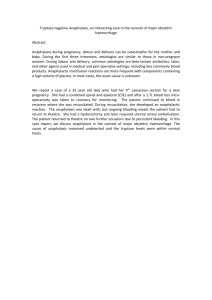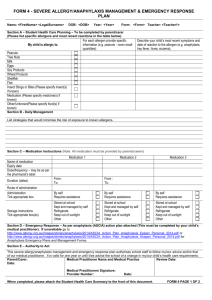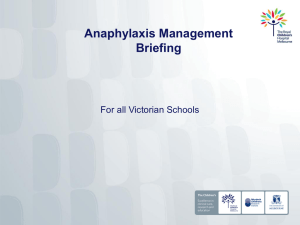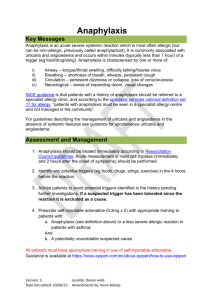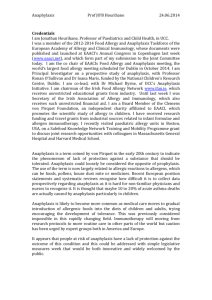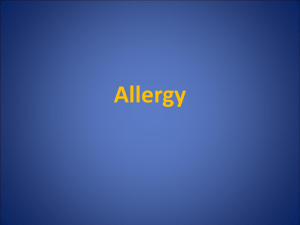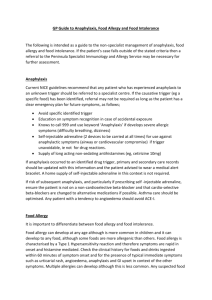Anaphylaxis – Students at Risk
advertisement
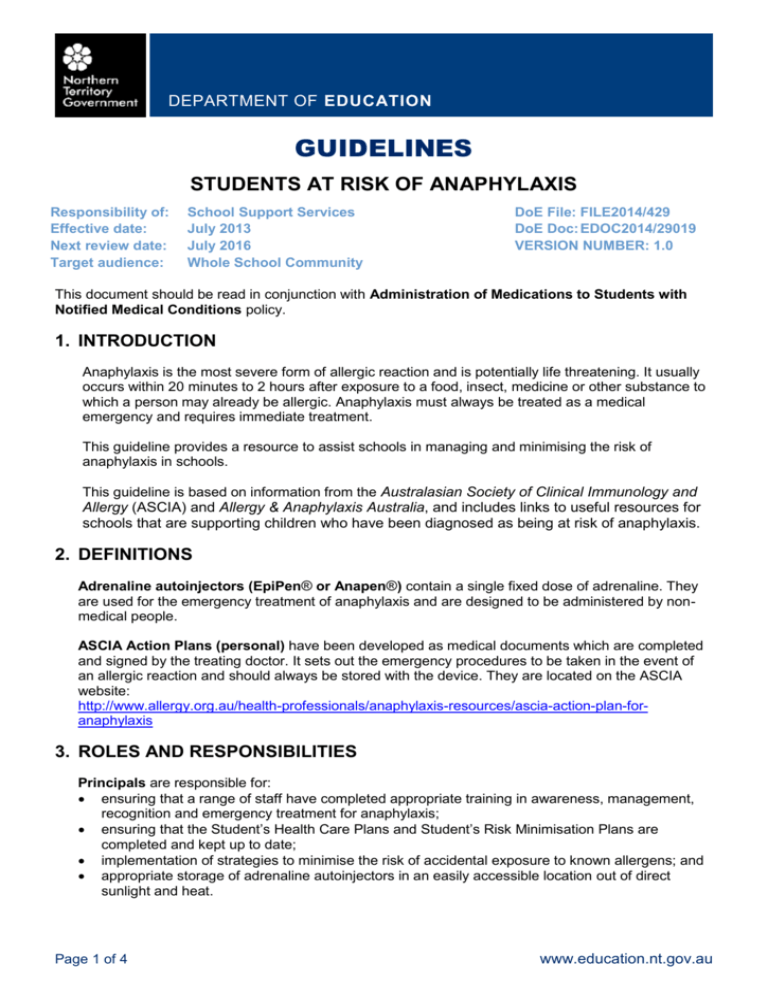
DEPARTMENT OF EDUCATION GUIDELINES STUDENTS AT RISK OF ANAPHYLAXIS Responsibility of: Effective date: Next review date: Target audience: School Support Services July 2013 July 2016 Whole School Community DoE File: FILE2014/429 DoE Doc: EDOC2014/29019 VERSION NUMBER: 1.0 This document should be read in conjunction with Administration of Medications to Students with Notified Medical Conditions policy. 1. INTRODUCTION Anaphylaxis is the most severe form of allergic reaction and is potentially life threatening. It usually occurs within 20 minutes to 2 hours after exposure to a food, insect, medicine or other substance to which a person may already be allergic. Anaphylaxis must always be treated as a medical emergency and requires immediate treatment. This guideline provides a resource to assist schools in managing and minimising the risk of anaphylaxis in schools. This guideline is based on information from the Australasian Society of Clinical Immunology and Allergy (ASCIA) and Allergy & Anaphylaxis Australia, and includes links to useful resources for schools that are supporting children who have been diagnosed as being at risk of anaphylaxis. 2. DEFINITIONS Adrenaline autoinjectors (EpiPen® or Anapen®) contain a single fixed dose of adrenaline. They are used for the emergency treatment of anaphylaxis and are designed to be administered by nonmedical people. ASCIA Action Plans (personal) have been developed as medical documents which are completed and signed by the treating doctor. It sets out the emergency procedures to be taken in the event of an allergic reaction and should always be stored with the device. They are located on the ASCIA website: http://www.allergy.org.au/health-professionals/anaphylaxis-resources/ascia-action-plan-foranaphylaxis 3. ROLES AND RESPONSIBILITIES Principals are responsible for: ensuring that a range of staff have completed appropriate training in awareness, management, recognition and emergency treatment for anaphylaxis; ensuring that the Student’s Health Care Plans and Student’s Risk Minimisation Plans are completed and kept up to date; implementation of strategies to minimise the risk of accidental exposure to known allergens; and appropriate storage of adrenaline autoinjectors in an easily accessible location out of direct sunlight and heat. Page 1 of 4 www.education.nt.gov.au DoE Guidelines: Students At Risk Of Anaphylaxis Staff are responsible for: knowing the identity of students who are at risk of anaphylaxis; following information contained in the Student’s Health Care Plan, Student’s Risk Minimisation Plan and ASCIA Action Plan (if supplied by parent); knowing where the adrenaline autoinjector is located, whether it is carried by the student or stored in an agreed location. Parents of children at risk of anaphylaxis are responsible for: notifying the school if their child has been prescribed an adrenaline autoinjector, had previous or subsequent anaphylaxis, has any changes in allergies and any other health care needs or disabilities that may affect anaphylaxis management; working with the school to complete the Student’s Health Care Plan and Student’s Risk Minimisation Plan; where necessary providing an in date adrenaline autoinjector and ASCIA Action Plan to the school; educating their child about the condition and how to avoid known allergens; and reinforcing the risk minimisation strategies outlined in the Student’s Health Care Plan and Student’s Risk Minimisation Plan. 4. GUIDELINES Anaphylaxis is potentially life threatening and always requires an emergency response. The most common allergens or trigger substances that may cause anaphylaxis in school aged children are peanuts, tree nuts, fish, shellfish, egg, cows’ milk, wheat, sesame, soy, insect stings, latex and certain medications. 4.1 Notification of Student at Risk of Anaphylaxis Parents are required to notify the school on enrolment or on diagnosis if their child has been medically diagnosed with a severe allergy and is at risk of anaphylaxis. A Health Care Plan and EpiPen/Anapen Student Information Form must be completed. As allergies, particularly food allergies, change with time it is important that schools ensure that the Health Care Plan is reviewed and amended as circumstances change or if a serious incident involving the student’s medical condition occurs. The Health Care Plan should be reviewed at least at the start of every semester (six monthly). All staff must be advised of the relevant details of an individual student’s severe allergy. 4.2 Student’s Risk Minimisation Plan Each student known to be at risk must also have a Student’s Risk Minimisation Plan which details strategies to support prevention, recognition and management of anaphylaxis. The Student’s Risk Minimisation Plan is developed on enrolment or diagnosis in consultation with the student’s parents and Health Care Team. As a minimum, the Student’s Risk Minimisation Plan should be reviewed in conjunction with the review of the Health Care Plan, so that management strategies can be changed if required. Strategies may differ as the student gets older and has more understanding of personal management. A student may also outgrow an allergy or develop another allergy. Where provided by parents, a copy of the ASCIA Action Plan should be attached to the Student’s Risk Minimisation Plan. Page 2 of 4 www.education.nt.gov.au DoE Guidelines: Students At Risk Of Anaphylaxis 4.3 Education and Awareness Where schools have students with severe allergies, schools should deliver age appropriate awareness and education programs, especially in classes where there are affected student/s. ASCIA provide an extensive range of information and resources to assist in the education and management of anaphylaxis and severe allergic reactions. http://www.allergy.org.au/health-professionals/anaphylaxis-resources Allergy & Anaphylaxis Australia provide free downloadable resources on their website to help schools raise awareness of anaphylaxis. In particular, Be a M.A.T.E – Make Allergy Treatment Easier is an educational awareness program designed to help parents and educators to teach students and staff about food allergies and how to help their friends who are at risk of anaphylaxis. http://www.allergyfacts.org.au/caring-for-those-at-risk/school-resources 4.4 School Risk Minimisation Measures It is important that schools have strategies in place to minimise the risk of any severe allergic reaction. These strategies will vary depending on the age of the student/s and the type of allergies the school is required to manage. For schools where there are children with severe food allergies a risk minimisation policy for school canteens should also be implemented. It may be possible to minimise students’ exposure to potential allergens within the school environment through the implementation of food bans or prohibiting the entry of particular substances into schools or classrooms. Schools, however, should not make claims that their school is, for example, “peanut/nut free” as this is impossible to guarantee and may lead to a false sense of security about exposure to allergens. As a general principle it is not recommended that students with an allergy be physically isolated from other students. The following resources outline strategies and measures to minimise students’ exposure to known allergens: ASCIA Guidelines for Preventions of Anaphylaxis in Schools, Preschools and Childcare: 2012 Update http://www.allergy.org.au/health-professionals/papers/prevent-anaphylactic-reactions-in-schools Discussion Guides: Ideas on Risk Minimisation Strategies in the School and/or Childcare Environment http://www.allergyfacts.org.au/images/pdf/risk.pdf 4.5 Staff Training The Principal will determine which members of staff are required to complete anaphylaxis training, involving online and practical training in recognising and responding appropriately to an anaphylactic reaction including administering adrenaline autoinjectors. The following needs to be considered when determining how many staff are to be trained: number of students with severe allergy at risk of anaphylaxis at the school, variety of activities these students engage in as part of the school program, and level of associated risk. Page 3 of 4 www.education.nt.gov.au DoE Guidelines: Students At Risk Of Anaphylaxis A register of staff who participate in the practical training component is required to be maintained by the school. It is recommended that the ASCIA Action Plans (General) are used as posters and placed in first aid kits. http://www.allergy.org.au/health-professionals/anaphylaxis-resources/ascia-action-plan-foranaphylaxis Discussion Guide: Who should be trained? http://www.allergyfacts.org.au/images/pdf/trained.pdf ASCIA offers a free online training course which the Department recommends for all Principals and staff. It is a resource for learning about the symptoms, triggers, adrenaline autoinjectors and management. Practical training on administering adrenaline autoinjectors can be facilitated through a range of first aid training providers such as St John’s Ambulance and the Asthma Foundation. Online training – ASCIA anaphylaxis e-training for schools and childcare http://www.allergy.org.au/patients/anaphylaxis-e-training-schools-and-childcare 4.6 Preschools Preschools in scope of the National Quality Framework must further meet the requirements outlined in the Education and Care Services National Regulations. These include, but are not limited to: the preschool must have a person who has undertaken approved anaphylaxis management training in attendance or on the school site and immediately available in case of an emergency at all times; a medical conditions policy which sets out practices in relation to the management of a child at risk of anaphylaxis; and display of a notice which is clearly visible in the main entrance advising that a child enrolled at the service has been diagnosed as at risk of anaphylaxis. Further details are provided on the Australian Children’s Education and Care Quality Authority (ACECQA) website: http://www.acecqa.gov.au/First-aid-qualifications-and-training. 5. USEFUL RESOURCES Australasian Society of Clinical Immunology and Allergy http://www.allergy.org.au/ Allergy & Anaphylaxis Australia http://www.allergyfacts.org.au/ EpiPen® http://www.epiclub.com.au/ Anapen® http://www.analert.com.au/ Page 4 of 4 www.education.nt.gov.au
